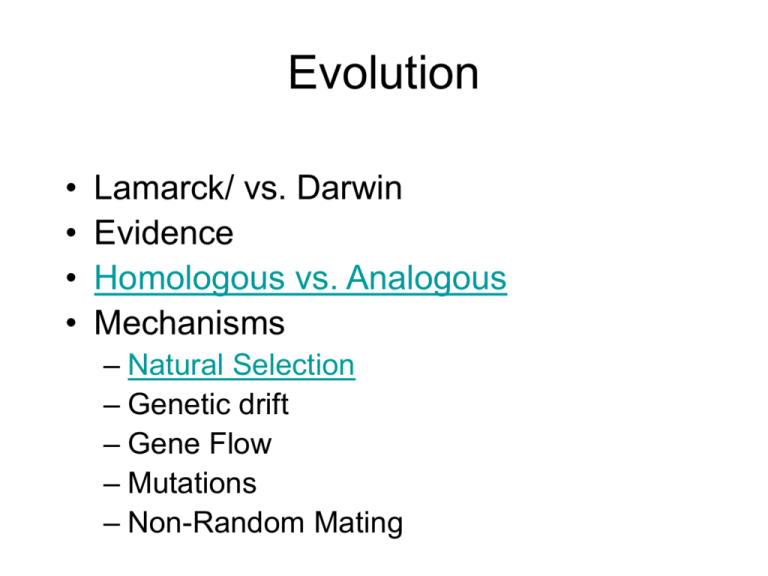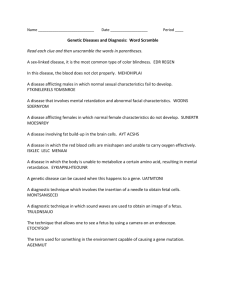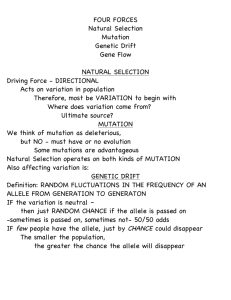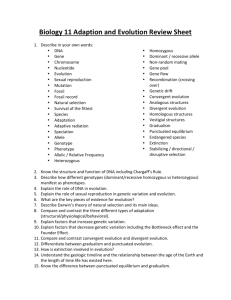Evolution - gloriousbiology
advertisement

Evolution • • • • Lamarck/ vs. Darwin Evidence Homologous vs. Analogous Mechanisms – Natural Selection – Genetic drift – Gene Flow – Mutations – Non-Random Mating In what way are these organisms displaying examples of convergent evolution? 2. Mice that are homozygous for a lethal recessive allele die shortly after birth. In a large breeding colony of mice, you find that a surprising 5% of all newborns die from this trait. In checking lab records, you discover that the same proportion of offspring have been dying from this trait in this colony for the past three years. (Mice breed several times a year and have large litters.) How might you explain the persistence of this lethal allele at such a high frequency? – – – – – Homozygous recessive mice have a reproductive advantage. A large mutation rate keeps producing this lethal allele. There is some sort of heterozygote advantage and perhaps selection against the homozygous dominant trait. Genetic drift has kept the recessive allele at this high frequency in the population. Since this is a diploid species, the recessive allele cannot be selected against when it is in the heterozygote. 3. Genetic analysis of a large population of mink inhabiting an island in Michigan revealed an unusual number of loci where one allele was fixed. Which of the following is the most probable explanation for this genetic homogeneity? * – The population exhibited nonrandom mating, producing homozygous genotypes. – The gene pool of this population never experienced mutation or gene flow. – A very small number of mink may have colonized this island, and this founder effect and subsequent genetic drift could have fixed many alleles. – Natural selection has selected for and fixed the best adapted alleles at these loci. – The colonizing population may have had much more genetic diversity, but genetic drift in the last year or two may have fixed these alleles by chance. 4. Increased UV irradiation causes the skin of humans to become more darkly pigmented over a period of days. The notion that the offspring of such tanned individuals should consequently inherit darkened skin from their parents is consistent with the ideas of – – – – – Charles Darwin. Carolus Linnaeus. Alfred Wallace. Jean Baptiste Lamarck. Charles Lyell. 5. A biologist studied a population of squirrels for 15 years. Over that time, the population was never fewer than 30 squirrels and never more than 45. Her data showed that over half of the squirrels born did not survive to reproduce, because of competition for food and predation. Suddenly, the population increased to 80. In a single generation, 90% of the squirrels that were born lived to reproduce. What inferences might you make about that population? – The amount of available food probably increased. – The number of predators probably decreased. – The young squirrels in the next generation will show greater levels of variation than in the previous generations because squirrels that would not have survived in the past are now surviving. – All three of these are reasonable inferences. – Only B and C are reasonable inferences. 6. In a hypothetical environment, fishes called pike-cichlids are visual predators of algae-eating fish, i.e., they locate their prey by sight. If a population of algae eaters experiences predation pressure from pike-cichlids, then which of the following should not be observed in the algae-eater population over the course of many generations? – Coloration of the algae eaters may become drab. – The algae eaters may become nocturnal (active only at night). – Female algae eaters may become larger, bearing broods composed of more, and larger, young. – The algae eaters may become sexually mature at smaller overall body sizes. – The algae eaters may become faster swimmers. 7. When chemicals are used to control unwanted organisms, then the wisest application strategy, in light of natural selection and assuming that chemicals generally have negative effects on the environment, is to apply – – – – – a large dose of a single chemical. a small dose of a single chemical. a moderate dose of a single chemical. large doses of several different chemicals. moderate doses of several different chemicals. 8. As adults, certain species of whales possess baleen instead of teeth. Baleen is used to filter the whales' diet of planktonic animals from seawater. As embryos, baleen whales possess teeth, which are later replaced by baleen. The teeth of embryonic baleen whales are evidence that – all whales are the descendants of terrestrial mammals. – baleen whale embryos pass through a stage when they resemble adult toothed whales. – baleen whales are descendants of toothed whales. – ontogeny recapitulates phylogeny. – among ancient whales, baleen evolved before teeth. 1. A botanist identifies a new species of plant that has 32 chromosomes. It grows in the same habitat with three similar species: species A (2n 5 14), species B (2n 5 16), and species C (2n 5 18). Suggest a possible speciation mechanism for the new species. – allopatric divergence by development of a reproductive isolating mechanism. – change in a key developmental gene that causes the plants to flower at different times. – autopolyploidy, perhaps due to a nondisjunction in the formation of gametes of species B. – allopolyploidy, a hybrid formed from species A and C. – Either answer c or d could account for the formation of this new plant species • The following question refers to this information: In the year 2500, five male space colonists and five female space colonists from Earth settle on an uninhabited Earthlike planet in the Andromeda galaxy. The colonists and their offspring randomly mate for generations. All ten of the original colonists had free ear lobes, and two are heterozygous for that trait. The allele for free ear lobes is dominant to the allele for attached ear lobes 2.After many generations, the population on this planet has an unusually high frequency for the incidence of retinitis pigmentosa, relative to Earth's population. This is most likely due to – the founder effect. – sexual selection. – the inheritance of acquired characteristics. – mutations. – the bottleneck effect. The restriction enzymes of bacteria protect the bacteria from successful attack by bacteriophage, whose genomes can be degraded by the restriction enzymes. The bacterial genomes are not vulnerable to these restriction enzymes because bacterial DNA is methylated. This situation selects for bacteriophage whose genomes are also methylated. As new strains of resistant bacteriophage become more prevalent, this in turn selects for bacteria whose genomes are not methylated and whose restriction enzymes 3.Over the course of evolutionary time, what should occur? – Methylated DNA should become fixed in the gene pools of bacterial species. – Nonmethylated DNA should become fixed in the gene pools of bacteriophage. – Methylated DNA should become fixed in the gene pools of bacteriophage. – Methylated and nonmethylated strains should be maintained among both bacteria and bacteriophage, with ratios that vary over time. – Both A and B are correct. 4. A balanced polymorphism exists through diversifying selection in seedcracker finches from Cameroon in which small- and large-billed birds specialize in cracking soft and hard seeds, respectively. If long-term climatic change resulted in all seeds becoming hard, what type of selection would then operate on the finch population? – – – – – diversifying selection. directional selection stabilizing selection sexual selection No selection would operate because the population is in Hardy-Weinberg equilibrium. • A biologist discovers two populations of wolf spiders whose members appear identical. Members of one population are found in the leaf litter deep within the woods. Members of the other population are found in the grass at the edge of the woods. The biologist decides to designate the members of the two populations as two separate species. Which species concept is this biologist most closely utilizing? – – – – – Ecological Biological Morphological Pluralistic genealogical 2. The formation of a land bridge between North and South America about three million years ago should have resulted in which of the following? I. allopatry of marine populations that were previously sympatric II. sympatry of marine populations that were previously allopatric – I III. onlysympatry of terrestrial populations that were – II only previously allopatric – III only – I and II – I and III 3. If two subspecies, A and B, are not considered separate species even though they cannot interbreed, then – they are groups that are endemic to isolated geographic regions. – they have eliminated postzygotic barriers but not prezygotic barriers. – gene flow between A and B may exist through other related subspecies. – gene flow has ceased and genetic isolation is complete. – their diploid gametes are produced by nondisjunction. • • • • Populations (Hardy Weinberg) Speciation, Reproductive isolation Adaptive Radiation Modes of Natural Selection AP Labs and Essays • • • • • • Lab 8 1992, # 4 1996, # 4 1997, # 4 2001, # 2 2004, # 3








